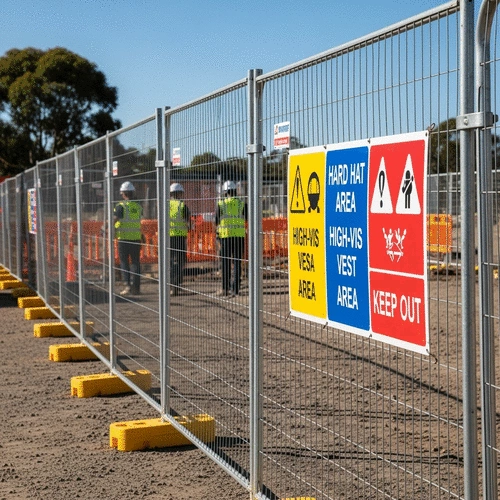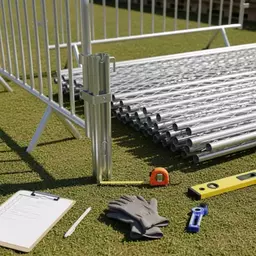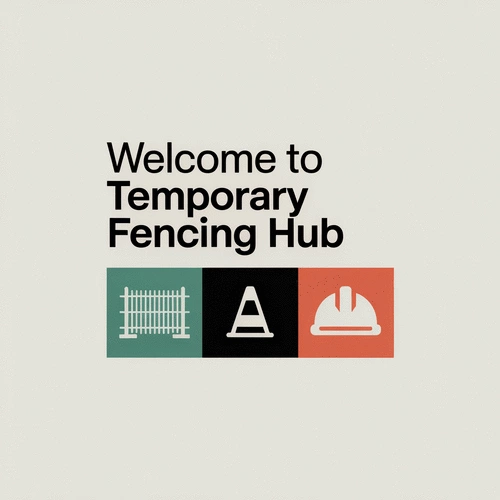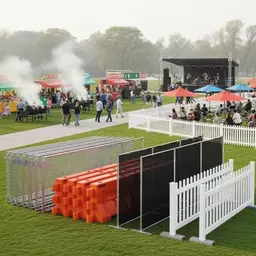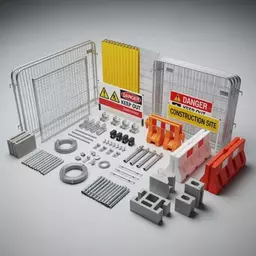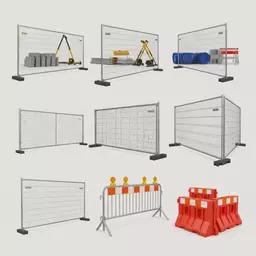Have you ever considered how crucial compliance is for ensuring safety at construction sites and events? Understanding the Australian safety regulations for temporary fencing can significantly impact your project's success and safety. Let’s explore key insights into these regulations that can help you stay informed and compliant.
What You Will Learn
- The AS 4687:2022 standard outlines essential specifications for temporary fencing, ensuring safety and compliance.
- Material quality is critical; fencing must be robust and weather-resistant to withstand environmental conditions.
- Regular inspections and maintenance of temporary fencing are not just best practices but legal requirements under the Work Health and Safety Act.
- Non-compliance can lead to significant safety risks, financial penalties, and damage to your professional reputation.
Key Australian Temporary Fencing Regulations & Compliance Steps
This visual outlines the core Australian safety standards for temporary fencing and the critical steps for maintaining compliance. For a detailed guide on selecting the right fencing, refer to our post on Choosing the Right Temporary Fencing for Your Project.
Core Regulation: AS 4687:2022
The primary standard outlining specifications for temporary fencing and crowd control systems in Australia.
- Material Quality
- Panel Heights
- Installation Guidelines
Other Key Regulations & Acts
Beyond AS 4687, other acts and regulations ensure comprehensive safety.
- Work Health and Safety Act
- Local Council Regulations
- Australian Standards Compliance
Maintaining Compliance: Inspections
Regular checks are crucial to uphold safety and legal requirements.
- Identify wear and tear early
- Ensure local regulation adherence
- Enhance overall site safety
Consequences of Non-Compliance
Failing to comply can lead to severe safety and financial repercussions.
- Significant safety risks
- Financial fines and penalties
- Damage to business reputation
Understanding Australian Safety Regulations for Temporary Fencing
When it comes to temporary fencing, understanding Australian safety regulations is crucial for ensuring compliance and safety at your construction sites or events. The backbone of these regulations is encapsulated in the AS 4687:2022, which outlines the standards for temporary fencing and crowd control systems. This ensures that the fencing is not just functional but safe for all users, including workers and event attendees.
As the founder of Temporary Fencing Hub, I cannot stress enough the importance of staying updated with these regulations. They are designed to protect both the public and the workers involved in various projects. Let’s dive deeper into the relevant standards and specifications that govern temporary fencing in Australia.
Overview of AS 4687:2022 and Relevant Standards
The AS 4687:2022 standard encompasses several key specifications that all temporary fencing systems must adhere to. Understanding these can help you select the right solution for your needs. Here’s a breakdown of some critical elements:
- Material Quality: The fencing materials must be robust and weather-resistant to withstand various environmental conditions.
- Panel Heights: Minimum panel heights must be met to ensure adequate safety and security.
- Installation Guidelines: Proper installation procedures are essential to maintain stability and effectiveness throughout the fencing's use.
These specifications are not just guidelines; they are essential for ensuring that your temporary fencing is effective and complies with national safety standards.
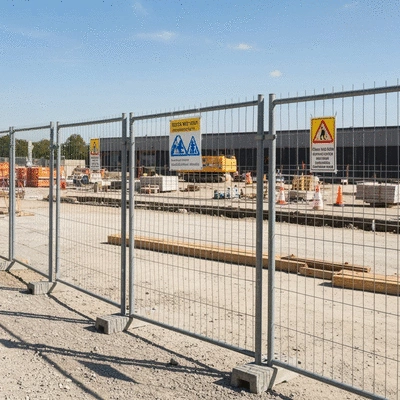
Key Specifications for Temporary Fencing
Each specification within AS 4687:2022 has been meticulously crafted to address potential risks associated with temporary fencing. For example, the material quality is crucial for ensuring durability, while the panel heights must be sufficient to prevent unauthorized access and protect the public. I often recommend reviewing these specifications with your fencing supplier to ensure you’re compliant from the start.
Historical Context and Updates to Australian Standards
Historically, temporary fencing standards have evolved significantly in Australia, shaped by past incidents and the ongoing need for improved safety measures. The updates in AS 4687:2022 reflect a learning curve in the industry, emphasizing the importance of compliance and the necessity for adaptable solutions. Keeping up with these changes is vital for anyone involved in managing temporary fencing solutions and staying updated on A Comprehensive Guide to Temporary Fencing Regulations in Australia.
Key Australian Safety Regulations Impacting Temporary Fencing
In addition to AS 4687:2022, several other regulations play a pivotal role in temporary fencing safety in Australia. Being aware of these can assist you in navigating the complex landscape of compliance requirements.
- Work Health and Safety Act: This act outlines the responsibilities of employers to ensure a safe working environment.
- Local Council Regulations: Different regions may have unique requirements that must be adhered to for temporary fencing.
- Australian Standards Compliance: Adhering to local standards ensures that your fencing solutions meet both state and national safety requirements.
Each regulation has been established to protect workers and the public alike, and understanding them helps you ensure that your fencing practices are both safe and legally compliant.
Compliance with the Work Health and Safety Act
The Work Health and Safety Act mandates that all temporary fencing systems must be designed and installed with a focus on safety. This means regular inspections and maintenance are not just best practices; they are legal requirements. By following these regulations, you can significantly reduce the risk of accidents and potential fines.
Role of Regulatory Authorities in Fencing Standards
Regulatory authorities play a crucial role in establishing, enforcing, and updating safety standards for temporary fencing. They provide guidance and support to businesses to ensure compliance. I recommend connecting with local authorities regularly to stay informed about any changes that may affect your temporary fencing solutions.
You might consider searching for videos like "How to Erect Temporary Fencing - DIY At Bunnings" or related content from sources like Bunnings or 1300TempFence, which often provide practical advice on temporary fencing installation and maintenance.
We Want to Hear From You!
What challenges have you faced when selecting temporary fencing? Share your thoughts below:
Maintaining Compliance: Key Takeaways for Stakeholders
When it comes to temporary fencing, staying compliant isn't just a best practice—it's essential! Regular inspections and maintenance play a pivotal role in ensuring the safety of your construction sites and events. At Temporary Fencing Hub, we understand how crucial it is to keep your fencing in top condition to mitigate risks and reduce costs.
By implementing a consistent inspection routine, you can identify potential issues before they escalate into significant problems. Remember, a well-maintained temporary fence not only provides safety but also builds trust with your clients and stakeholders!
Importance of Regular Inspections and Maintenance
Regular inspections of temporary fencing are vital for maintaining compliance and ensuring the safety of all involved. The frequency and thoroughness of these inspections can drastically reduce risks and costs associated with fencing failure.
- Identify wear and tear early to prevent costly repairs
- Ensure compliance with local safety regulations
- Enhance the overall safety environment for workers and attendees
Implementing a structured maintenance schedule can help you avoid fines and liabilities that arise from non-compliance. I always recommend keeping a log of inspections and repairs to track the history of your temporary fencing. This practice not only aids in maintaining safety but also provides documentation if needed during audits! You can find more tips on this in our guide to Essential Tips for Maintaining and Extending the Life of Your Temporary Fence.

How Proper Practices Reduce Risks and Costs
Adopting proper inspection and maintenance practices can significantly lower risks and costs associated with temporary fencing. Here are some ways how:
- Preventative Maintenance: Regular checks can identify issues like loose panels or damaged structures before they lead to accidents.
- Cost Efficiency: Investing in maintenance reduces the likelihood of expensive emergency repairs or replacements.
- Peace of Mind: Knowing your site is compliant allows you to focus on other important aspects of your project.
These practices not only protect those on the site but also ensure that your investment in temporary fencing continues to pay off. Just as I’ve seen with many of my clients, proactive management is the key to success!
Understanding the Legal Implications of Non-Compliance
Non-compliance with temporary fencing regulations can lead to serious legal implications. It's important to understand that failing to adhere to the established standards can put you at risk for liability issues and potential lawsuits. Let’s break this down further!
- Safety Risks: Non-compliant fencing can lead to accidents that endanger workers and the public.
- Financial Consequences: Fines and penalties can accumulate quickly if you are found non-compliant.
- Reputation Damage: Non-compliance can tarnish your reputation, affecting future contracts and partnerships.
When I consult with clients, I always emphasize the importance of understanding and adhering to legal requirements. Not only does this help to ensure safety, but it also protects your business from potential liabilities that can arise from negligence!
Why Compliance is Essential for Safety and Liability
Compliance isn't just about following rules; it's about fostering a safety-first culture. By prioritizing compliance in your temporary fencing practices, you enhance the safety of your project and reduce liability risks. Here are a few reasons why compliance is essential:
- It reinforces a commitment to safety, showing clients and workers that you take their well-being seriously.
- Compliance helps avoid costly legal battles and penalties that can arise from negligence.
- It builds trust and credibility with stakeholders, which is crucial for long-term success.
As someone who has seen the ramifications of non-compliance in the field, I cannot stress enough how essential it is to stay informed and proactive. Together, we can ensure your temporary fencing meets all necessary regulations, keeping everyone safe and your project running smoothly!
Taking the Next Steps for Improved Temporary Fencing
Now that we've established the importance of compliance, let’s explore some actionable steps you can take to improve your temporary fencing management. From utilizing digital tools to engaging professionals, these steps will help you maintain high safety standards. For instance, understanding the different roles of temporary fencing in various applications can further enhance your strategic approach.
Frequently Asked Questions (FAQs)
- What is the primary Australian standard for temporary fencing?
- The primary standard is AS 4687:2022, which outlines specifications for temporary fencing and crowd control systems in Australia.
- What are the key aspects covered by AS 4687:2022?
- Key aspects include material quality, panel heights, and installation guidelines to ensure stability, effectiveness, and safety.
- Beyond AS 4687:2022, what other regulations impact temporary fencing?
- Other significant regulations include the Work Health and Safety Act and various Local Council Regulations, which dictate specific requirements for different regions.
- Why are regular inspections and maintenance important for temporary fencing?
- Regular inspections and maintenance are crucial for identifying wear and tear early, preventing costly repairs, ensuring compliance with local safety regulations, and enhancing overall site safety. They are also legal requirements under the Work Health and Safety Act.
- What are the consequences of non-compliance with temporary fencing regulations?
- Non-compliance can lead to significant safety risks, financial fines and penalties, and damage to a business's reputation.
Recap of Key Points
Here is a quick recap of the important points discussed in the article:
- Understand and adhere to the AS 4687:2022 standard to ensure safety and compliance for temporary fencing.
- Regular inspections and maintenance are essential for mitigating risks and ensuring the safety of construction sites and events.
- Stay informed about local council regulations and the Work Health and Safety Act to navigate compliance requirements effectively.
- Engage with regulatory authorities to keep abreast of updates in safety standards and regulations.
- Prioritize compliance to build trust with clients and avoid potential legal repercussions and financial penalties.

